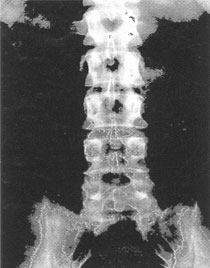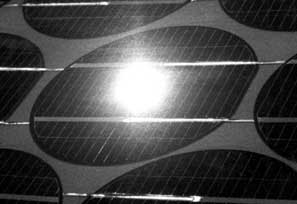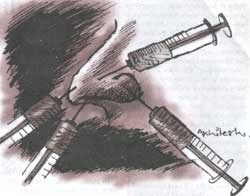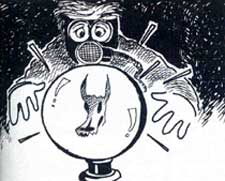Garlic gets pride of place in Haryana
Haryana, which ranks second in per hectare production of garlic in the country, is now emerging as a trend-setter in popularising the production of this bulb crop which is a major foreign exchange
Haryana, which ranks second in per hectare production of garlic in the country, is now emerging as a trend-setter in popularising the production of this bulb crop which is a major foreign exchange
Fast food giant Mcdonalds is violating the rules, the chain's outlet at Janpath in Connaught Place has put up bulbs on a tree. A tree situated outside the Janpath restaurant has been lit up with a
India is home to an estimated 125 varieties of Bamboo, a grass that has been used in products from aphrodisiacs to light bulb filaments. The belated realisation that this resource can be worth a lot

Some neurone functions restore on their own following a spinal cord or brain damage

Solar power helps prevent rusting
Scientists Are Building First Worldwide Portrait Of Human Impact That Has Left Just 4% Of The Seas Pristine In 1980, after college, I joined the crew of a sailboat partway through a circumnavigation of the globe. Becalmed and roasting one day during a 21-day crossing of the western Indian Ocean, several of us dived over the side. Within a few swimming strokes, the bobbing hull seemed a toy over my shoulder as I glanced back through my diving mask. Below me, my shadow and the boat's dwindled to the vanishing point in the two-mile-deep water. Human activity seemed nothing when set against the sea itself. Just a few weeks later, on an uninhabited island in a remote part of the Red Sea, I was proved wrong. The shore above the tide line was covered with old light bulbs, apparently tossed from the endless parade of ships over the years. Now scientists are building the first worldwide portrait of such dispersed human impacts on the oceans, revealing a planet-spanning mix of depleted resources, degraded ecosystems and disruptive biological blending as species are moved around the globe by accident and intent. A paper in the February 15 issue of the journal Science is the first effort to map 17 kinds of human ocean impacts like organic pollution, including agricultural runoff and sewage; damage from bottomscraping trawls; and intensive traditional fishing along coral reefs. About 40% of ocean areas are strongly affected, and just 4% pristine, according to the review. Polar seas are in the pristine category, but poised for change. Some human impacts are familiar, like damage to coral reefs and mangrove forests through direct actions like construction and subtler ones like the loss of certain fish that shape ecosystems. Others were a surprise, said Benjamin S Halpern, the lead author and a scientist at the National Center for Ecological Analysis and Synthesis in Santa Barbara, California. He said continental shelves and slopes proved to be the most heavily affected areas, particularly along densely populated coasts. The most widespread human fingerprint is a slow drop in the pH of surface waters around the world as a portion of the billions of tons of carbon dioxide added to the atmosphere from fuel and forest burning each year is absorbed in water, where it forms carbonic acid. That progressive shift in ocean chemistry could eventually disrupt shell-forming plankton and reef-building species, particularly where other impacts, including rising temperatures from human-caused global warming, create simultaneous stresses, many marine biologists say. "I study this stuff all the time and didn't expect the impacts to be as pervasive as we found,' Halpern said. The review provides a baseline necessary for tracking further shifts, he said. It also identifies some unanticipated trouble spots, similar to terrestrial biodiversity "hot spots' that environmental groups have identified over the years. NYT NEWS SERVICE

In 2006, Nicholas Stern former chief economist, World Bank and advisor to the UK government, wrote about the economic threat from climate change in the Stern Report. He veers round to an uneasy

The humble nose can revolutionise the way brain diseases are currently treated
The EU offers a solution to disposal and recycling of CFLs. Under its Waste Electrical and Electronic Equipment Directive of 2005, it is the responsibility of the manufacturer to collect and recycle the spent bulbs. Collection of these bulbs can take place at the point of sale or at e-waste collection points. The customer can return the CFL from where he or she bought it. Manufacturers have

Research on solar cookers has remained the enclave of Gandhian innovators
Elected leaders in New York City will propose a suite of laws and other initiatives on Wednesday aimed at reducing energy consumption and related emissions of greenhouse gases by requiring owners of thousands of older buildings to upgrade everything from boilers to light bulbs.
Environment Elisabeth Rosenthal and Felicity Barringer Light emitting diodes could decrease carbon dioxide emissions by up to 50 per cent in just over 20 years TO CHANGE the bulbs in the 60-foothigh ceiling lights of Buckingham Palace
ENLIGHTENING: Actor R.Sarath Kumar switches on an LED light bulb as part of the run-up to the 99999 lights-out campaign, in Chennai on Sunday. Exnora International Founder M.B.Nirmal is in the picture.

The pollen so sharp that the wind sneezed, its belly so speckled with rashes that it turned visible. The way the fish walked up the beaches you'd think they had turned amphibian.
Alzheimer's disease (AD) is a mental disorder resulting from brain degeneration. It affects almost 1 in 10 individuals over the age of 65. The disease is characterised by confusion, personality and

Telecommunications and the television (TV) broadcasting sectors have been most instrumental in ushering in what is called the ‘Information society’ / ‘global village’. Although the telecom sector in India is slowly coming on track, with regulators taking

An investment of Rs 300 can bring electricity to every household in rural India. Humble cow dung can do this and more

A BBC serial says strong political will is needed to ensure that energy is used efficient.
For promoting usage of energy saving compact fluorescent lamps (CFLs) in the country, leading lamp manufacturer Osram will distribute more than 2 million CFL units to poor families in Mahrashtra, Haryana and Andhra Pradesh. A unit of CFL will cost around Rs 10- 15 while actual cost of the unit is around Rs 300. Osram has already carried out the ground works for the project, which is expected launched over the next few weeks. "We have signed MoUs with respective state electricity boards and the project would be financed through carbon credit generated through the clean development mechanism (CDM) under United Nations Framework Convention on Climate Change (UNFCC),' Gagan Mehra, managing director of Osram India told FE. However the company is yet to decide volume of carbon credit needed for the implementation of the project. Osram model for CDM is an arrangement under the Kyoto protocol for reducing CO2 emission in the lighting industry. The company in collaboration with state electricity boards will distribute special CFL bulbs with a longevity of 15 thousands hours amongst the poorer section of the population. "We have identified as present districts such as Visakhapatanam in Andhra Pradesh, Sonepat and Yamuna Nagar in Haryana and Pune in Maharashtra for distribution of CFL units and gradually the programme would include other districts in the state,' Mehra said. Osram would be importing most of the components of the CFLs to be distributed in the three states and it would be assembled at the Sonepat plant of the company. "As the project would be in operation for seven to 10 years in three states, after two years of implementation, we plan to manufacturer the CFLs at our plant,' Mehra said. Mehra admitting that despite the low energy consumption by CFLs, the disposal of these bulbs has been a key issue. "All the manufacturers of CFLs are working out a strategy for proper disposals of these bulbs with the Electricity Lamp and Components Manufacturers Association of India (ELCOMA),' he said.
This year, the surging current of the East River will help provide power to a nearby subway station. The lights that lace the ornate interior of Manhattan's Grand Central Station have largely been replaced by bulbs that burn brightly but save energy. There are plans to make the rooftop of a Queens bus depot bloom like a garden. "Carbon footprint" has become part of the national lexicon, and mass transit systems throughout the country are taking steps to ease their impact on the environment even as they strive to provide more service to a growing number of riders.